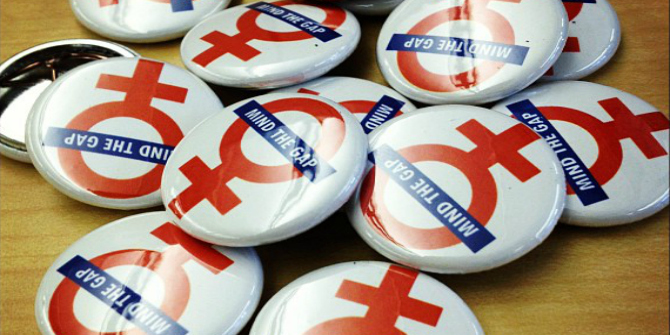In Feminist City: Claiming Space in the Man-Made World, Leslie Kern delves into the interlocking inequalities and systems of oppression that take concrete shape in cities, using an intersectional feminist approach to explore the gendered aspects of urban space. This is an enjoyable and accessible book that not only contributes to urban feminist geography, but to urban planning and policy more broadly, write Reha Atakan Cetin.
Feminist City: Claiming Space in the Man-Made World. Leslie Kern. Verso. 2020.
Find this book (affiliate link): ![]()
 Historically, urban spaces have been the centres of uneven power relations, oppressive socio-political structures and exclusionary and discriminatory practices. Despite some progress, women, disabled people, people of colour, gender and sexual minorities, immigrants as well as Indigenous communities are still being marginalised and excluded from decision- and policymaking processes. In turn, cities become the major spheres of inequality and oppression that further shape the ways in which these groups experience public and private life.
Historically, urban spaces have been the centres of uneven power relations, oppressive socio-political structures and exclusionary and discriminatory practices. Despite some progress, women, disabled people, people of colour, gender and sexual minorities, immigrants as well as Indigenous communities are still being marginalised and excluded from decision- and policymaking processes. In turn, cities become the major spheres of inequality and oppression that further shape the ways in which these groups experience public and private life.
In Feminist City: Claiming Space in the Man-Made World, urban feminist geographer Leslie Kern delves into these inequalities and systems of oppression that take concrete shape in cities. Starting from an analysis of gendered aspects of the urban space, Kern aims to bring ‘women’s questions’ into the discussion by combining her own biographical experience, feminist urban scholarship and popular culture. Throughout five major chapters, Kern comprehensively utilises an intersectional feminist intervention to examine how ‘women still experience the city through a set of barriers – physical, social, economic, and symbolic – that shape their daily lives in ways that are deeply (although not only) gendered’ (5).
The way Kern discusses the struggles and ideals of the ‘Feminist City’ by utilising her own experience in combination with urban scholarship and popular culture (e.g. novels and movies) creates engaging content for the reader. In this regard, from being a mother to a ‘white gentrifier’, Kern successfully locates her own struggles, challenges and experiences in the city within urban feminist thinking. In providing such self-reflection, she acknowledges her position as a white, middle-class, cisgender woman, although this acknowledgement is not always apparent throughout the chapters, leading to an intermittent positionality problem in which the author becomes both an insider and outsider to certain inequalities that concern, for instance, particular racial and sexual minorities. Nevertheless, Kern often impressively manages her own positionality while reflecting on women’s questions ‘that emerge from the everyday, embodied experience of those who include themselves in the dynamic and shifting category ‘‘women’” (8). Here, it is crucial to mention that such an inclusionary approach to these questions is broad enough to encompass a variety of experiences, such as those of disabled women and trans women.
In this respect, Kern’s analytical focus on embodied experiences is very similar to Brenda K. Parker’s Masculinities and Markets (2017), in which Parker suggests the concept of amplification that refers to the ‘intensity of racialized women’s work, life, and bodily experiences’ (119). This amplification of bodily experiences such as exhaustion and pain emerges as a result of everyday labour (Parker, 2017). Like Parker’s research, Kern’s emphasis on the bodily influence of urban design and life is conceptually appropriate in examining various inequalities that persist in the city, contributing to the theoretical and empirical development of intersectional feminist knowledge production.
In addition to this methodological strength, the theoretical framework paves the way for a broader understanding of uneven power relations and interlocking systems of oppression. Under this intersectional approach, there are several conceptual debates that contribute to the urban feminist literature. In this regard, gentrification and attempts at constructing a non-sexist city, such as through gender-mainstreaming strategies, will be conceptually analysed in this review.

Image Credit: Photo by Sara Aho on Unsplash
Firstly, Kern’s analysis of gentrification in relation to women’s experiences deserves closer attention. Her discussion of gentrification starts with the interesting argument that women can be both the drivers and beneficiaries of gentrification and urban renewal (Winifred Curran, 2018). By also reflecting on her own experiences in Toronto, Kern adds aspects of motherhood into the discussion of gentrification. Here, the ‘gentrification of parenting’ emerges as a result of ‘intensive mothering’, a process in which the individual mother is held responsible for child-centred, labour-intensive, financially expensive and emotionally absorbing childcare (Sharon Hays, 1996), and the ‘mystique of motherhood’, a view that glorifies motherhood as the ultimate achievement of women (Andrea O’Reilly, 2010). These analyses reveal an intersectional understanding of how urban renewal processes prioritise ‘particular product brands, styles, and kinds of activities’ (40) and reinforce intersectional inequalities while excluding working-class families and mothers from gentrified urban environments.
Moreover, it is ironic to see that older queer spaces, which once appealed to LGBTQ communities, have become sites of exclusion and displacement for queer women, due to increasing living costs, income gaps and the diminishing amount of welcoming urban space. It then becomes visible that the selective nature of gentrification leads to more uneven and ‘deeply altered’ (78) places in which newly emerging urban facilities become available only to a small portion of communities as queer women, trans and non-binary people find themselves in less resourced environments. These findings confirm previous studies exploring the effect of gentrification on queer spaces where gentrification pressures lead to a ‘de-gaying’ effect, resulting in the displacement of certain queer communities with limited socio-economic resources (Doan and Higgins, 2011; Doan, 2016). As a result, as Kern mentions, queer women, trans and non-binary people attempt to seek alternative ways for establishing inclusive spaces as an essential part of their urban survival.
Secondly, it is necessary to discuss the strategies offered for constructing a non-sexist city. During the 1970s and 1980s, particularly in North America, cooperative housing developments emerged as part of feminist city design initiatives. These housing developments focused on the collective needs of lower-income communities with shared spaces for cooking, housework and childcare. As Kern argues, these initiatives have the potential to be amongst existing alternative visions as part of an urban feminist response to housing issues. However, as also acknowledged by Kern, such solutions unfortunately did not last very long as they have been quickly replaced by neoliberal housing environments that rely on the underpaid labour of others as well as the ability to pay more for facilities and services, especially in the areas of care work and cleaning.
As an alternative vision, I suggest that ‘gender mainstreaming’ strategies that have emerged in the European context might be more promising. Aiming to diminish gender-based inequalities, gender mainstreaming refers to a more comprehensive and contemporary approach in policy design, implementation and evaluation with particular consideration of the varied needs of men and women (Council of Europe, 2020). Successful examples of this are evident in major European cities, such as Vienna and Paris, where urban planners, feminist designers, city dwellers and decision/policymakers come together and work on inclusive strategies such as on-site child and healthcare services, ‘redesigning areas to facilitate pedestrian mobility’ (47), as well as developing the accessibility of existing public transport facilities by being more sensitive to gender-specific needs.
Nonetheless, as Kern points out, there are concerns about the real effectiveness of these strategies in eliminating inequalities. There might be ‘a danger of reinforcing already existing gender norms and roles’, and ‘taking gender as the primary category for equality’ can be somewhat misleading (49). However, gender mainstreaming is becoming a broader concept as there are many examples attempting to acknowledge the variety of needs of particular groups (Clare Foran, 2013). While recognising the concerns of Kern, the broader scope of this gender mainstreaming approach, I argue, has the potential to pave the way for a more inclusive urban space. Such a vision of social coexistence can be widely applicable when it is strategically designed in accordance with the needs of marginalised communities, in addition to the recognition of gender-based inequalities. A more revised approach to mainstreaming may include broadening binary gender categories, recognising the intersections of gender with other social dimensions of power and the development of participatory methodologies in line with these broader conceptualisations (Rachel Tolhurst et al, 2012).
Feminist City has several limitations. First, as acknowledged by Kern, the research scope and content are largely limited to examples, cases, experiences and studies drawn from the Global North. Although the book may not be considered ‘traditional’ empirical research that offers specific theories and data, the engagement of theory and knowledge on the intersectional urban feminist approach requires a much broader analysis that should be sensitive to shared struggles, experiences and strategies concerning women around the globe. Thus, while I understand that the book is centred around self-reflection, the incorporation of urban feminist knowledge from the Global South would make the analysis more convincing and generalisable.
Second, except for a few points that emerge at the end of the chapters, the author does not provide concrete and comprehensive answers to ‘women’s questions’ as the provision and interpretation of ‘alternative visions’ are largely left to the reader. On the one hand, as Kern suggests, it is essential to recognise the diversity of issues when it comes to intersectional inequalities. This makes it unrealistic to apply one single solution or to have an overarching ‘master’ plan where there are ‘endless options’ (176). On the other hand, more examples are needed, both from the Global North and South, to point out new possibilities for overcoming these inequalities. I argue that using existing examples, strategies and interventions that have the potential to be more widely applied would pave the way for a better understanding of how new possibilities might be realised in different urban environments and contexts.
Lastly, there is an omittance of contemporary debates around several major and pressing urban issues, including food (in)security and environmental struggles and their relevance to urban feminist knowledge production. Except for a few pages, for instance, there is no detailed analysis of how environmental pollution and climate change affect women’s experiences in urban areas. There is a growing literature on the nexus of gender and environmental issues (see Diana Reckien et al, 2017; Brenda Parker and Oona Morrow, 2017; Lucy Atkinson, 2014; Emma Huddart Kennedy and Liz Dzialo, 2015), and in this respect, despite its comprehensive content, Feminist City misses a great opportunity to contribute to these discussions that have direct roots in women’s experiences within contemporary urban environments.
Nonetheless, excepting the few points mentioned above, Feminist City’s broad scope, structured around an intersectional feminist approach, successfully grapples with the most recent debates that have emerged at the intersections of race, gender, class and sexualities. From the analysis of queer women’s spaces to racialised social movements, it adds scholarly value to the literature not only on urban feminist geography, but also urban planning and policy as well as the social sciences more broadly. Moreover, with its clarity in language and writing, the chapters are easy to follow and read. Combined with the author’s engaging content on popular culture through references to movies, television series and books, this makes Feminist City enjoyable and accessible to a more general audience.
Note: This review gives the views of the author, and not the position of the LSE Review of Books blog, or of the London School of Economics. The LSE RB blog may receive a small commission if you choose to make a purchase through the above Amazon affiliate link. This is entirely independent of the coverage of the book on LSE Review of Books.








1 Comments